 |
|
|
|
|
 How To Solve Puzzles
How To Solve Puzzles
How to Solve Nurikabe Puzzles
by Thomas Snyder
Nurikabe puzzles were first published in 1991 by Nikoli in quarterly Communication 33; the original author was れーにん (Lenin). The name Nurikabe derives from a spirit in Japanese folklore that forms a wall to misdirect travelers.
Basic Rules
Nurikabe puzzles consist of a rectangular grid and numbers that act as clues. Solve the puzzle by shading certain cells according to the following rules:
- All shaded cells must be connected.
- Each numbered cell must be part of an unshaded region of cells that is surrounded on all sides by shaded cells.
- Each region must be comprised of a number of cells equal to the number it contains.
- No two regions may be connected adjacently.
- There cannot be any 2×2 block of shaded cells anywhere in the grid.
- Unless stated explicitly, there is only one valid solution.
General Solving Strategies
Cells containing a 1 must become single-celled regions, so you can shade all horizontally and vertically adjacent cells.
As you solve, you will find cells that must be shaded and cells that cannot be shaded (called unused cells). It is a good idea to mark these cells as soon as you discover them. You may also find it useful to mark cells that you think are going to be shaded (called tentative cells).
Good places to start are where numbered cells (also called clue cells) are near each other, either separated by one cell or diagonally adjacent. Since all numbered cells must be part of their own regions, you must shade in certain cells between nearby numbered cells in order to separate their regions. This means that you can shade in any cells that are adjacent to two numbered cells.
While shading cells, keep in mind that each region must be the size of its clue number. This means that if a region is not yet completed, you can determine the possible route(s) for expansion. Oftentimes there is only one route and you can mark the appropriate cells to note that they must remain unused. Even when there are multiple routes, figuring them out can usually provide you with some cells which must be shaded and some which must remain unused. The corners and borders of the grid also help determine which cells should be shaded or not.
Nurikabe Path Puzzles
A Nurikabe Path puzzle follows the same rules, except with one additional requirement — the shaded cells must form a single-cell path that connects the starting cell to the ending cell without any branches or crossings. Here are some tips for solving this type of Nurikabe variant.
The easiest places to start are where two numbers are close to each other, as the path must somehow separate those numbers from touching, and on the border of the grid because it is not as easy for the path to turn there. Whenever the path touches the border, it must use at least three cells to be able to turn and get back into the middle of the grid.
Be careful to shade all forced path cells and unused cells as you proceed. Except for the start and end of the path, every path cell will have exactly two cells on the top/bottom/left/right edges shaded. Once you know those two cells, any other cells that share an edge with that path cell must be unused. Then try to figure out what number clues those new unused cells can reach. Similarly, when you finish a numbered region by accounting for all the cells in its area, be sure to shade all cells that share an edge with the region. Then try to figure out if these new path cells help to identify more path segments, or possibly more unused cells once enough adjacent path cells are filled in.
There may be some cells that no number clue can reach so these must be shaded; conversely, in some tight spaces there may be cells that the path cannot reach without forming a dead-end and these must be unused. Alternating between thinking about the path and thinking about the unused cells is a good strategy.
Sample Nurikabe Path
Here is a sample Nurikabe Path puzzle. Disregard the lettered cells while solving. When the puzzle is complete, the path will cover some of these letters, which when read in order, will spell out an extra word or phrase.
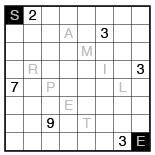
For the example puzzle, the upper-right corner cannot be reached by any number so it must be part of the path. This allows you to quickly shade seven path cells and one more unused cell.
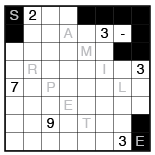
Edge cells are sometimes hard to reach without blocking the path. Consider row 1, column 4. If this is not part of the path, then row 1, column 3 must be part of the path but this would form a dead-end. So R1C4 is shaded and, because the path is a single cell wide, R2C5 must be the last cell in the 3 region in row 2, and you can now shade the rest of the cells necessary to close off that region.
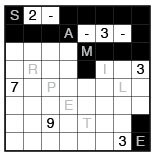
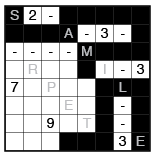
To finish the puzzle, figure out how to get the path between the 7 and 9 clues; you’ll find it needs to get into the bottom-left corner, but giving enough cells to each of the 7 and 9 clues leaves only one solution.
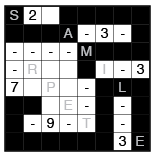
The completed puzzle is shown below. Note that the shaded letters spell out the word SAMPLE.
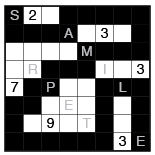
Hints
If you get stuck, don’t forget you can get hints by tapping on the  icon.
You have the option to reveal any cell and also to clear errors.
It’s not cheating to ask for a hint — the goal is to
have fun, so if asking for a hint increases your enjoyment, feel free.
icon.
You have the option to reveal any cell and also to clear errors.
It’s not cheating to ask for a hint — the goal is to
have fun, so if asking for a hint increases your enjoyment, feel free.



|
Our Puzzle Books Buy Gift Certificates
Our World-Class Authors
How to Solve Puzzles
Our exclusive, award-winning TouchWrite™ handwriting recognition
Special features: Puzzles Live 2013 100th Anniversary of the Crossword
Get the puzzle of the day:
Read the latest Puzzazz Newsletter
About Us Contact Us Support FAQ Read the Buzz about Puzzazz
Your account Redeem a coupon or special offer
Cookies: If you sign in, we use a cookie for that purpose. We also use cookies to manage your browser session.
If you use third-party services, such as Facebook, with Puzzazz, they may use cookies following their own policies.
© 2026 Puzzazz Privacy Policy



